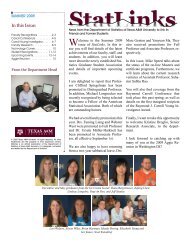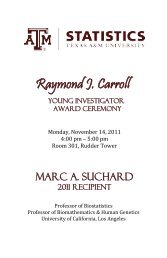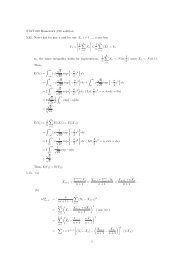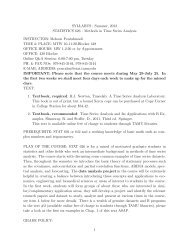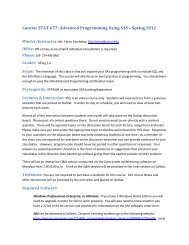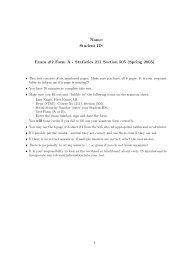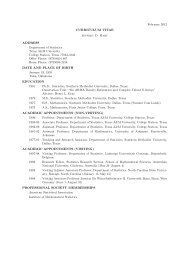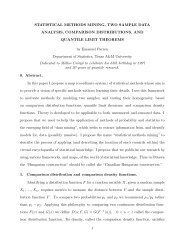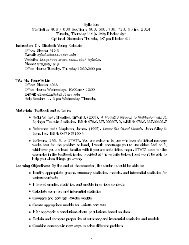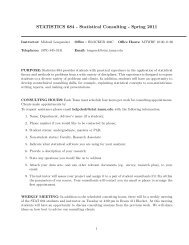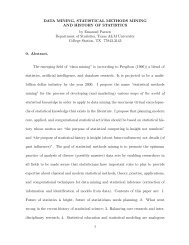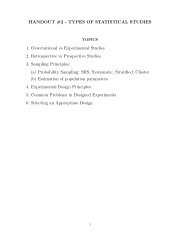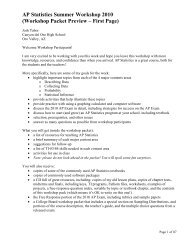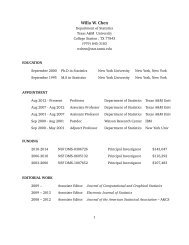Chapter 18: Split-Plot, Repeated Measures, and Crossover Designs
Chapter 18: Split-Plot, Repeated Measures, and Crossover Designs
Chapter 18: Split-Plot, Repeated Measures, and Crossover Designs
You also want an ePaper? Increase the reach of your titles
YUMPU automatically turns print PDFs into web optimized ePapers that Google loves.
<strong>Chapter</strong> <strong>18</strong>: <strong>Split</strong>-<strong>Plot</strong>, <strong>Repeated</strong> <strong>Measures</strong>, <strong>and</strong> <strong>Crossover</strong> <strong>Designs</strong><br />
1 Introduction<br />
When the experiment involves a factorial treatment structure, the implementation of one or two<br />
factors may be more time-consuming, more expensive, or require more material than the other<br />
factors. In situations such as these, a split-plot design is often implemented. For example, in an<br />
educational research study involving two factors, teaching methodologies <strong>and</strong> individual tutorial<br />
techniques, the teaching methodologies would be applied to the entire classroon of students. The<br />
tutorial techniques would then be applied to the individual students within the classroom. In<br />
an agricultural experiment involving the factors, levels of irrigation <strong>and</strong> varieties of cotton, the<br />
irrigation systems must apply the water to large sections of l<strong>and</strong> which would then be subdivided<br />
into smaller plots. The different varieties of cotton would then be plantted on the smaller plots.<br />
In a crossover designed experiment, each subject receives all treatments. The individual subjects<br />
in the study are serving as blocks <strong>and</strong> hence decreasing the experimental error. This provides an<br />
increased precision of the treatment comparisons when compared to the design in which each subject<br />
receives a single treatment.<br />
In the repeated measures designed experiment, we obtain t different measurements corresponding<br />
to t different time points following administration of the assigned treatment. The multiple<br />
observations over time on the same subject often yield a more efficient use of experimental resources<br />
than using a different subject for each obsevation time. Thus, fewer subjects are required,<br />
with a subsequent reduction in cost. Also, the estimation of time trends will be measured with<br />
a greater degree of precision. Medical researchers, ecological studies, <strong>and</strong> numerous other areas<br />
of research involve the evaluation of time trends <strong>and</strong> hence may find the repeated measure design<br />
useful.<br />
1
2 <strong>Split</strong>-<strong>Plot</strong> Designed Experiments<br />
The yields of three different varieties of soybeans are to be compared under two different levels<br />
of fertilizer application. If we are interested in getting n = 2 observations at each combination of<br />
fertilizer <strong>and</strong> variety of soybeans, we would need 12 equal-sized plots. Taking fertilizer as factor A<br />
<strong>and</strong> varieties as a treatment factor T, one possible design would be an 2 × 3 factorial treatment<br />
structure with n = 2 observations per factor-level combination. However, since the application of<br />
fertilizer to a plot occurs when the soil is being prepared for planting, it would be difficult to first<br />
apply fertilizer A 1 to six of the plots dictated by the factorial arrangement of factors A <strong>and</strong> T <strong>and</strong><br />
then fertilizer A 2 to the other six plots before planting the required varieties of soybeans in each<br />
plot.<br />
An easier design to execute would have each fertilizer applied to two larger “wholeplots” <strong>and</strong><br />
then the varieties of soybeans planted in three “subplots” within each whole plot.<br />
This design is called a split-plot design, <strong>and</strong> with this design there is a two-stage r<strong>and</strong>omization.<br />
First, levels of factor A (fertilizers) are r<strong>and</strong>omly assigned to the wholeplots; second, the levels of<br />
factor T (soybeans) are r<strong>and</strong>omly assigned to the subplots within a wholeplot. Using this design,<br />
it would be much easier to prepare the soil <strong>and</strong> to apply the fertilizer to the larger wholeplots.<br />
Consider the model for the split-plot design with a levels of factor A, t levels of factor T, <strong>and</strong><br />
n repetitions of the i levels of factor A. If y ijk denotes the kth response for the ith level of factor<br />
A, jth level of factor T, then<br />
y ijk = µ + τ i + δ ik + γ j + τγ ij + ɛ ijk ,<br />
where<br />
• τ i : Fixed effect for ith level of A.<br />
• γ j : Fixed effect for jth level of T.<br />
• τγ ij : Fixed effect for ith level of A, jth level of T.<br />
• δ ik : R<strong>and</strong>om effect for the kth wholeplot receiving the ith level of A. The δ ik are independent<br />
normal with mean 0 <strong>and</strong> variance σδ 2.<br />
• ɛ ijk : R<strong>and</strong>om error.<br />
The δ ik <strong>and</strong> ɛ ijk are mutually independent.<br />
2
Table 1: An ANOVA table for a completely r<strong>and</strong>omized split-plot design.<br />
Source SS df EMS<br />
A SSA a − 1 σɛ 2 + tσδ 2 + tnθ τ<br />
Wholeplot Error SS(A) a(n − 1) σɛ 2 + tσδ<br />
2<br />
T SST t − 1 σɛ 2 + anθ γ<br />
AT SSAT (a − 1)(t − 1) σɛ 2 + nθ τγ<br />
subplot error SSE a(n − 1)(t − 1) σɛ<br />
2<br />
Total TSS atn − 1<br />
The ANOVA for this model <strong>and</strong> design is shown in Figure 1.<br />
The sum of squares can be<br />
computed using our st<strong>and</strong>ard formulas.<br />
Wholeplot analysis<br />
H 0 : θ τ = 0 (or, equivalently, H 0 : all τ i = 0), F = MSA<br />
MS(A) .<br />
Subplot Analysis<br />
H 0 : θ τγ = 0 (or, equivalently, H 0 : All τγ ij = 0), F = MSAT<br />
MSE .<br />
H 0 : θ γ = 0 (or, equivalently, H 0 : All γ j = 0), F = MST<br />
MSE .<br />
A variation on this design introduces a blocking factor (such as farms). Thus for our example,<br />
there may be b = 2 farms with a = 2 wholeplots per farm <strong>and</strong> t = 3 subplots per wholeplot. The<br />
model for this more general two-factor split-plot design laid off in b blocks is as follows:<br />
y ijk = µ + τ i + β j + τβ ij + γ k + τγ ik + ɛ ijk ,<br />
where y ijk denotes the measurement receiving the ith level of factor A <strong>and</strong> the kth level of factor<br />
T in the jth block. The parameters τ i , γ k , <strong>and</strong> τγ ik are the usual main effects <strong>and</strong> interaction<br />
parameters for a two-factor experiment, whereas β j is the effect due to block j <strong>and</strong> τβ ij is the<br />
interaction between the ith level of factor A <strong>and</strong> the jth block. The analysis corresponding to this<br />
model is shown in Table 2.<br />
• Wholeplot analysis.<br />
H 0 : θ τ = 0 (or, equivalently, H 0 : all τ i = 0), F = MSA<br />
MSAB .<br />
• Subplot analysis.<br />
H 0 : θ τγ = 0 (or, equivalently, H 0 : all τγ ik = 0), F = MSAT<br />
MSE .<br />
H 0 : θ γ = 0 (or, equivalently, H 0 : all γ k = 0), F = MST<br />
MSE .<br />
3
Table 2: An ANOVA table for a r<strong>and</strong>omized split-plot design (A, T fixed; block r<strong>and</strong>om.<br />
Source SS df EMS<br />
Blocks SSB b − 1 σɛ 2 + atσβ<br />
2<br />
A SSA a − 1 σɛ 2 + tστβ 2 + btθ τ<br />
AB(Wholeplot Error) SSAB (a − 1)(b − 1) σɛ 2 + tστβ<br />
2<br />
T SST t − 1 σɛ 2 + abθ γ<br />
AT SSAT (a − 1)(t − 1) σɛ 2 + bθ τγ<br />
subplot error SSE a(b − 1)(t − 1) σɛ<br />
2<br />
Total TSS abt − 1<br />
Example 2.1 Soybeans are an important crop throughout the world. A study was designed to<br />
determine if additional phosphorus applied to the soil would increase the yield of soybean. There<br />
are three major varieties of soybeans of interest (V 1 , V 2 , V 3 ) <strong>and</strong> four levels of phosphorus (0, 20,<br />
40, 65, pounds per acre). The researchers have nine plots of l<strong>and</strong> available for the study which<br />
are grouped into blocks of three plots each based on the soil characteristics of the plots. Because<br />
of the complexities of planting the soybeans on plots of the given size, it was decided to plant a<br />
single variety of soybeans on each plot <strong>and</strong> then divide each plot into four subplots. The researchers<br />
r<strong>and</strong>omly assigned a variety to one plot within each block of three plots <strong>and</strong> then r<strong>and</strong>omly assigned<br />
the levels of phosphorus to the four subplots within each plot. The yields (bushels/acre) froom the<br />
36 plots are given in Table <strong>18</strong>.5 of the textbook.<br />
For this study, we have a r<strong>and</strong>omized complete block design with a split-plot structure. Variety,<br />
with 3 levels, is the wholeplot treatment <strong>and</strong> amount of phosphorus is the split-plot treatment. The<br />
ANOVA analysis is as follows.<br />
The results indicate that there is a significant variety by phosphorus interaction from which we<br />
can conclude that the relationship between average yield <strong>and</strong> amount of phosphorus added to the<br />
soil is not the same for the three varieties.<br />
The distinction between this two-factor split-plot design <strong>and</strong> the st<strong>and</strong>ard two-factor experiments<br />
discussed in <strong>Chapter</strong> 14 lies in the r<strong>and</strong>omization. In a split-plot design, there are two stages<br />
to the r<strong>and</strong>omization process; first levels of factor A are r<strong>and</strong>omized to the wholeplots within each<br />
block, <strong>and</strong> then levels of factor B are r<strong>and</strong>omized to the subplot units within each wholeplot of<br />
every block. In contrast, for a two-factor experiment laid off in a r<strong>and</strong>omized block design, the<br />
4
Table 3: An ANOVA table for a r<strong>and</strong>omized split-plot design (A, T fixed; block r<strong>and</strong>om).<br />
Source df SS MS F p-value<br />
Blocks 2 763.25 381.63 * *<br />
V 2 671.81 335.90 232.60 < .0001<br />
BV(Wholeplot Error) 4 6.56 1.64 * *<br />
P 3 408.37 136.12 601.04 < 0.0001<br />
PV 6 117.41 19.57 86.40 < 0.0001<br />
subplot error <strong>18</strong> 4.08 0.23<br />
Total 35 1971.48<br />
r<strong>and</strong>omization is a one-step procedure; treatments (factor-level combinations of the two factors)<br />
are r<strong>and</strong>omized to the experimental units in each block.<br />
5
3 Single-Factor Experiments with <strong>Repeated</strong> <strong>Measures</strong><br />
In Section <strong>18</strong>.1, we discussed some reasons why one might want to get more than one observation<br />
per patient. Consider a design, three compounds are administered in sequence to each of the n<br />
patients. A compound is administered to a patient during a given treatment period. After a<br />
sufficiently long “washout” period, another compound is given to the same patient. This procedure<br />
is repeated until the patient has been treated with all three compounds. The order in which the<br />
compounds are administered would be r<strong>and</strong>omized. The data is shown below.<br />
multicolumn4cPatient<br />
Compound 1 2 · · · n<br />
1 y 11 y 12 · · · y 1n<br />
2 y 21 y 22 · · · y 2n<br />
3 y 31 y 32 · · · y 3n<br />
The model for this experiment can be written as<br />
y ij = µ + τ i + δ j + ɛ ij ,<br />
where µ is the overall mean response, τ i is the effect of the ith compound, δ j is the effect of jth<br />
patient, <strong>and</strong> ɛ ij is the experimental error for the jth patient receiving the ith compound.<br />
For this model, we make the following assumptions:<br />
1. τ i s are constants with τ a = 0.<br />
2. The δ j are independent <strong>and</strong> normally distributed N(0, σδ 2).<br />
3. The ɛ ij s are independent of the δ j s.<br />
4. The ɛ ij s are normally distributed N(0, σɛ 2 ).<br />
5. The ɛ ij s have the following correlation relationship: ɛ ij <strong>and</strong> ɛ i ′ j are correlated for i ≠ i ′ ; <strong>and</strong><br />
ɛ ij <strong>and</strong> ɛ i ′ j ′ are independent for j ≠ j′ .<br />
That is, two observations from the same patient are correlated but observations from different<br />
patients are independent. From these assumptions it can be shown that the variance of y ij is<br />
σδ 2 + σ2 ɛ . A further assumption is that the covariance for any two observations from patient j,<br />
y ij <strong>and</strong> y i ′ j, is constant. These assumptions give rise to a variance-covariance matrix for the<br />
observations, which exhibits compound symmetry.<br />
6
The ANOVA table for the experiment is shown below.<br />
Source SS df EMS (A fixed, patients r<strong>and</strong>om)<br />
Patients SSP n − 1 σɛ 2 + aσδ<br />
2<br />
A SSA a − 1 σɛ 2 + nθ τ<br />
Error SSE (a − 1)(n − 1) σɛ<br />
2<br />
Totals TSS an − 1<br />
When the assumptions hold, <strong>and</strong> hence compound symmetry holds, the statistical test on factor<br />
A (F = MSA/MSE) is appropriate. The conditions under which the F test for factor A is valid<br />
are often not met because observations on the same patient taken closely in time are more highly<br />
correlated than are observations taken farther apart in time. So be careful about this.<br />
In general, when the variance-covariance matrix does not follow a pattern of compound symmetry,<br />
the F test for factor A has a positive bias, which allows rejection of H 0 : all τ i = 0 more<br />
often than is indicated by the critical F -value.<br />
Example 3.1 An exercise physiologist designed a study to evaluate the impact of the steepness of<br />
running courses on the peak heart rate (PHR) of well-conditioned runners. There are four five-mile<br />
courses that have been rated as flat, slightly steep, moderately steep, <strong>and</strong> very steep with respect to<br />
the general steepness of the terrain. The 20 runners will run each of the four courses in a r<strong>and</strong>omly<br />
assigned order. There will be sufficient time between the runs so that there should not be any<br />
carryover effect <strong>and</strong> the weather conditions during the runs were essentially the same. Therefore,<br />
the researcher felt confident that the model<br />
y ij = µ + τ i + δ j + ɛ ij<br />
would be appropriate for the experiment.<br />
The ANOVA table for the experiment is shown below:<br />
Source SS df EMS (A fixed, patients r<strong>and</strong>om) F Prob<br />
Runner 4048.44 19 213.08 11.21 < 0.0001<br />
Course 3619.25 3 1206.41 63.47 < 0.0001<br />
Error 1083.51 57 19.01<br />
Totals 8751.19 79<br />
7
From the output we have that the p-value associated with the F test of<br />
H 0 : µ 1 = µ 2 = µ 3 = µ 4 versus H 1 : not H 0<br />
has p-value< 0.0001. Thus, we conclude that there is significant evidence of a difference in the<br />
mean heart rates over the four levels of steepness.<br />
The estimated variance components are given by<br />
ˆσ 2 Error = MSE = 19.01<br />
ˆσ 2 Runner = MS Runner − MSE<br />
4<br />
=<br />
213.08 − 19.01<br />
4<br />
= 48.52<br />
Therefore, 72% of the variation in the heart rates was due to the differences in runners <strong>and</strong> 28%<br />
was due to all other sources.<br />
8
4 Two-factor Experiments with <strong>Repeated</strong> <strong>Measures</strong> on One of the<br />
Factors<br />
We can extend our discussion of repeated measures experiments to two-factor settings. For example,<br />
in comparing the blood-pressure-lowering effects of cardiovascular compounds, we could<br />
r<strong>and</strong>omize the patients so that n different patients receive each of the three compounds. <strong>Repeated</strong><br />
measurements occur due to taking multiple measurements across time for each patient. For example,<br />
we might be interested in obtaining blood pressure readings immediately prior to receiving a<br />
single dose of the assigned <strong>and</strong> then every 15 minutes for the first hour <strong>and</strong> hourly thereafter for<br />
the next 6 hours.<br />
This experiment can be described generally as follows. There are m treatments with n experimental<br />
units r<strong>and</strong>omly assigned to the treatments. Each experimental unit (EU) is assigned to a<br />
single treatment with t measurements taken on each of the EUs. The form of the data is shown<br />
below. Note that this is a two-factor experiment (treatment <strong>and</strong> time) with repeated measurements<br />
taken over the time factor.<br />
Time Period<br />
Treatment EU 1 2 · · · t<br />
1 1 y 111 y 112 · · · y 11t<br />
. · · · · · · · · · · · ·<br />
n y 1n1 y 1n2 · · · y 1nt<br />
.<br />
m 1 y m11 y m12 · · · y m1t<br />
. · · · · · · · · · · · ·<br />
n y mn1 y mn2 · · · y mnt<br />
The analysis of a repeated measurement design can, under certain conditions, be approximated<br />
by the methods used in a split-plot experiment.<br />
• Each treatment is r<strong>and</strong>omly assigned to an EU. This is the wholeplot in the split-plot design.<br />
• Each EU is then measured at t time points. This is considered the split-plot unit.<br />
• The major difference is that in a split-plot design, the levels of factor B are r<strong>and</strong>omly assigned<br />
to the split-plot EUs. In the repeated measurement design, the second r<strong>and</strong>omization does<br />
9
not occur, <strong>and</strong> thus there may be strong correlation between the measurements across time<br />
made on the same EU.<br />
The split-plot analysis is an appropriate analysis for a repeated measurement experiment only<br />
when the covariance matrix of the measurements satisfy a particular type of structure: Compound<br />
Symmetry:<br />
⎧<br />
σɛ ⎪⎨<br />
when i = i ′ , j = j ′<br />
Cov(y ijk , y i ′ j ′ k) = ρσɛ 2 when i = i ′ , j ≠ j ′<br />
⎪⎩ 0 when i ≠ i ′<br />
where y ijk is the measurement from the kth EU receiving treatment i at time j. Thus we have<br />
Corr(y ijk , y ij ′ k) = ρ.<br />
This implies that there is a constant correlation between observations no matter how far apart<br />
they are taken in time. This may not be realistic in many applications. One would think that<br />
observations in adjacent time periods would be more highly correlated than observations taken two<br />
or three time periods apart.<br />
The model can be written as<br />
y ijk = µ + τ i + d ik + β j + (τβ) ij + ɛ ijk<br />
where i = 1, . . . , m, j = 1, . . . , t, k = 1, . . . , n, τ i is the ith treatment effect, β j is the jth time<br />
effect, (τβ) ij is the treatment-time interaction effect, d ik is the subject-treatment interaction effect<br />
(r<strong>and</strong>om, independent, N(0, σd 2), ɛ ijk independent N(0, σɛ 2 ), <strong>and</strong> d ik <strong>and</strong> ɛ ijk are independently<br />
distributed.<br />
Let λ = tρ/2(1 − ρ). The ANOVA table for the split-plot analysis of a repeated measures<br />
experiment is given in Table 4, where the treatment <strong>and</strong> time effects are fixed.<br />
Based on Table 4, the following tests can be performed:<br />
• H 0 : θ τβ = 0<br />
• H 0 : θ β = 0<br />
F = MS trt∗time<br />
MSE<br />
F = MS time<br />
MSE<br />
10
Table 4: An ANOVA table for a two-factor experiment, repeated measures on one factor.<br />
Source df Expected Mean Squares<br />
TRT m − 1 σɛ 2 (1 + 2λ) + tσd 2 + ntθ τ<br />
EU(TRT) (n − 1)m σɛ 2 (1 + 2λ) + tσd<br />
2<br />
Time t − 1 σɛ 2 + nmθ β<br />
TRT*Time (m − 1) ∗ (t − 1) σɛ 2 + nθ τβ<br />
Error m(t − 1)(n − 1) σɛ<br />
2<br />
Total mnt − 1<br />
• H 0 : θ τ = 0<br />
F =<br />
MS T rt<br />
MS EU(trt)<br />
Example 4.1 In a study, three levels of a vitamin E supplement, zero (control), low, <strong>and</strong> high,<br />
were given to guinea pigs. Five pigs were r<strong>and</strong>omly assigned to each of the three levels of the vitamin<br />
E supplement. The weights of the pigs were recorded at 1, 2, 3, 4, 5, <strong>and</strong> 6 weeks after the beginning<br />
of the study. This is a repeated measurement experiment because each pig, the EU, is given only<br />
one treatment but each pig is measured six times.<br />
The ANOVA table for the example is as follows.<br />
Source df SS MS F p-value<br />
TRT 2 <strong>18</strong>548.07 9274.03 1.06 0.3782<br />
PIG(TRT) 12 105,434.20<br />
Week 5 142,554.50 28510.90 52.55 < 0.0001<br />
TRT*Week 10 9762.73 976.27 1.80 0.0801<br />
Error 60 32,552.60 542.54<br />
From this table, we find that there is not significant evidence of an interaction between the<br />
treatment <strong>and</strong> time factors.<br />
Since the interaction was not significant, the main effects of treatment <strong>and</strong> time can be analyzed<br />
separately. The p-value=0.3782 for treatment differences <strong>and</strong> p-value< 0.0001 for time differences.<br />
The mean weights of the pigs vary across the 6 weeks but there is not significant evidence of a<br />
difference in the mean weights for the three levels of vitamin E feed supplements. Therefore, the<br />
11
two levels of vitamin E supplement do not appear to provide an increase in the mean weights of<br />
the pigs in comparison to the control, which was a zero level of vitamin E supplement.<br />
12
5 <strong>Crossover</strong> <strong>Designs</strong><br />
In a crossover design, each experimental unit (EU) is observed under each of the t treatments<br />
during t observation times. It is important to emphasize the difference between a crossover design<br />
<strong>and</strong> the general repeated measurement design. In a repeated measurement design, the EU receives<br />
receives a treatment <strong>and</strong> then the EU has multiple observations or measurements made on it over<br />
time or space. The EU does not receive a new treatment between successive measurements.<br />
The crossover designs are often useful when a latin square is to be used in a repeated measurement<br />
study to balance the order positions of treatments, yet more subjects are required than<br />
called for by a single latin square. With this type of design, the subjects are r<strong>and</strong>omly assigned to<br />
the different treatment order patterns given by a latin square. Consider an experiment in which<br />
treatments A, B, <strong>and</strong> C are to be administered to each subject, <strong>and</strong> the three treatment order<br />
pattern are given by the latin square<br />
Order Position<br />
pattern 1 2 3<br />
1 A B C<br />
2 B C A<br />
3 C A B<br />
Suppose that 3n subjects are available for the study. Then n subjects will be assigned at<br />
r<strong>and</strong>om to each of the three order patterns in a latin square crossover design. Note that this design<br />
is a mixture of repeated measures (within subjects) <strong>and</strong> latin square (order patterns from a latin<br />
square).<br />
For this experiment, the model can be written as<br />
y ijkm = µ + ρ i + κ j + τ k + η m(i) + ɛ ijkm ,<br />
where i = 1, . . . , t, j = 1, . . . , t, k = 1, . . . , t, <strong>and</strong> m = 1, . . . , m. The term ρ i denotes the effect<br />
of the ith treatment order pattern, κ j denotes the effect of the jth order position, τ k denotes the<br />
effect of the kth treatment, <strong>and</strong> η m(i) denotes the effect of subject m which is nested within the ith<br />
treatment order pattern. Here we assume η m(i) are independent N(0, ση), 2 ɛ ijkm are independent<br />
N(0, σɛ 2 ) <strong>and</strong> independent of the η m(i) .<br />
The ANOVA table for the experiment is as follows.<br />
13
Source of Variation SS df EMS<br />
Patterns(P) SSP t − 1 σɛ 2 + rση 2 + nrθ ρ<br />
Order Position(O) SSO t − 1 σɛ 2 + nrθ κ<br />
Treatments(TR) SSTR t − 1 σɛ 2 + nrθ τ<br />
Subjects SSS t(n − 1) σɛ 2 + rση<br />
2<br />
Error SSE (t − 1)(nt − 2) σɛ<br />
2<br />
Total SST nt 2 − 1<br />
The formulas for the sums of squares follow the usual pattern:<br />
SST = ∑ i<br />
∑ ∑<br />
(y ijkm − ȳ ... ) 2<br />
j m<br />
SSP = nt ∑ i<br />
SSO = nt ∑ j<br />
(ȳ i... − ȳ .... ) 2<br />
(ȳ .j.. − ȳ .... ) 2<br />
SST R = nt ∑ k<br />
(ȳ ..k. − ȳ .... ) 2<br />
SSS = t ∑ i<br />
∑<br />
(ȳ i..m − ȳ .... ) 2<br />
m<br />
SSE = SST − SSP − SSO − SST R − SSS.<br />
Example 5.1 The following table contains data for a study of three different displays on the sale<br />
of apples, using a latin square crossover design. Six stores were used, with two assigned at r<strong>and</strong>om<br />
to each of the three treatment order patterns shown. Each display was kept for two weeks, <strong>and</strong> the<br />
observed variable was sales per 100 customers.<br />
Two-week Period(j)<br />
Pattern(i) Store 1 2 3<br />
1 m=1 9(B) 12(C) 15(A)<br />
m=2 4(B) 12(C) 9(A)<br />
2 m=1 12(A) 14(B) 3(C)<br />
m=2 13(A) 14(B) 3(C)<br />
3 m=1 7(C) <strong>18</strong>(A) 6(B)<br />
m=2 5(C) 20(A) 4(B)<br />
The ANOVA table for the data is as follows:<br />
14
The test for the treatment effect is<br />
Source of Variation SS df MS<br />
Patterns 0.33 2 0.17<br />
Order positions 233.33 2 116.67<br />
Displays <strong>18</strong>9.00 2 94.50<br />
Stores (within patterns) 21.00 3 7.00<br />
Error 20.33 8 2.54<br />
F = MST R<br />
MSE = 94.50<br />
2.54 = 37.2<br />
which is greater than F 0.05,2,8 = 4.46. Therefore, we conclude that there are differential sales effects<br />
for the three displays. Tests for pattern effects, order position effects, <strong>and</strong> store effects were also<br />
carried out. They indicated that order position effects were present, but no pattern or store effects.<br />
Order position effects here are associated with the three time periods in which the displays were<br />
studied, <strong>and</strong> may reflect seasonal effects as well as the results of special events, such as unusually<br />
hot weather in one period.<br />
If the order position effects are not approximately constant for all subjects (stores, etc.), a<br />
crossover design is not fully effective. It may then be preferable to place the subjects into homogeneous<br />
groups with respect to the order position effects <strong>and</strong> use independent latin squares for each<br />
group.<br />
Carryover Effects If carryover effects from one treatment to another are anticipated, that is, if<br />
not only the order position but also the preceding treatment has an effect, these carryover effects<br />
may be balanced out by choosing a latin square in which every treatment follows every other<br />
treatment an equal number of times. For t = 4, an example of such a latin square is<br />
Period<br />
Subject 1 2 3 4<br />
1 A B D C<br />
2 B C A D<br />
3 C D B A<br />
4 D A C B<br />
15
Note that treatment A follows each of the other treatments once, <strong>and</strong> similarly for the other<br />
treatments. This design is appropriate when the carryover effects do not persist for more than one<br />
period.<br />
When t is odd, the sequence balance can be obtained by using a pair of latin squares with the<br />
property that the treatment sequences in one square are reversed in the other square.<br />
For the earlier apple display illustration in which three displays were studied in six stores, the<br />
two latin squares might be as shown in the next table. The stores should first be placed into two<br />
homogeneous groups <strong>and</strong> these should then be assigned to the two lattin squares.<br />
Two-week Period(j)<br />
Square Store 1 2 3<br />
1 A B C<br />
1 2 B C A<br />
3 C A B<br />
4 C B A<br />
2 5 A C B<br />
6 B A C<br />
6 Research Study: Effects of Oil Spill <strong>and</strong> Plant Growth<br />
On January 7, 1992, an underground oil pipline ruptured <strong>and</strong> caused the contamination of a marsh<br />
along the Chiltipin Creek in San Patricio County, Texas. The cleanup process consisted of burning<br />
the contaminated regions in the marsh. To evaluate the influence of the oil spill on the flora,<br />
the researchers concentrated their findings with respect to Distichlis Spicata, a flora of particular<br />
importance to the area of the spill. Two questions of importance to the researchers were as follows:<br />
1. Did the oil site recover after the spill <strong>and</strong> burning?<br />
2. How long did it take for the recovery?<br />
At both the oil spill site <strong>and</strong> the control site 20 tracts were r<strong>and</strong>omly chosen. After a 9-month<br />
transition period, measurements were taken at approximately 3-month intervals for a total of 8 time<br />
periods. During each time period, the number of Distichlis spicata within each of the 40 tracts was<br />
recorded. The resulting ANOVA table is as follows.<br />
16
Table 5: ANOVA for research study: Effects of oil spill on plant growth.<br />
Source SS df MS F p-value<br />
Treatment 10511.11 1 10511.11 6.56 0.0045<br />
Tracts in treatment 60844.63 38 1601.17<br />
Date 2845.09 7 406.44 19.35 0.0001<br />
Date×treatment 602.29 7 86.04 4.01 0.0001<br />
Error 5587.88 266 21.01<br />
17



